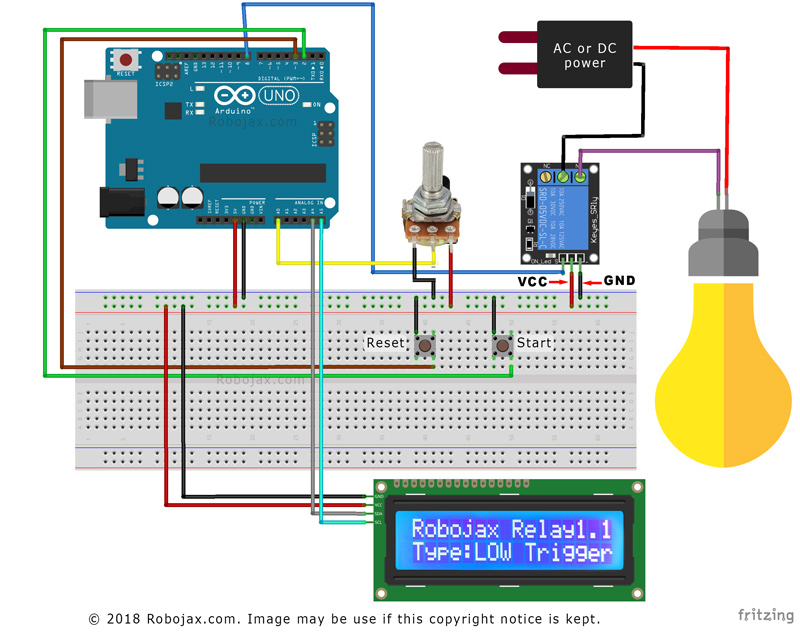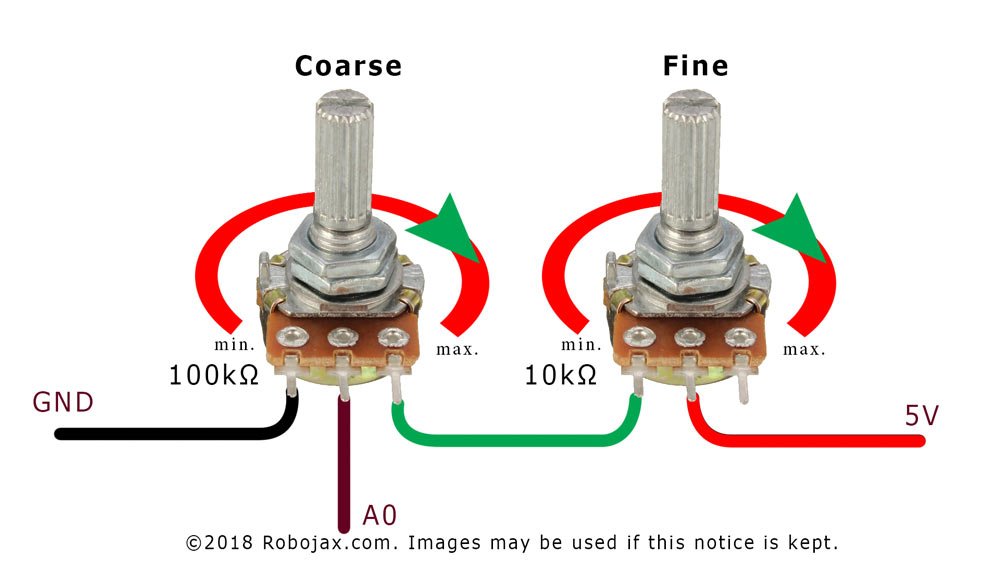Other Arduino Codes and Videos by Robojax
This code is to use Arduino as timer to control relay with potentiometer and LCD1602-I2C. You can set from 0 to any number of seconds. There is virtually no limit.

Fig. 1 Schematic diagram for Robojax Relay Timer V 1.1 with LCD1602-I2C
To have finer control over time setting. Specially time above 100 seconds, use two potentiometers with values 1:10 (one is 10 times larger than the other.) For example for coarse control use 100kΩ variable resistor and for fine control use 10kΩ and connect them as shown in Fig. 2.

Fig. 2 Wiring of Fine and coarse control for two potentiometers
/*
* Arduino code for Relay timer with potentiometer and LCD1602 with I2C
* Version 1.1 Display is added to show the set time
*
* this Arduino sketch makes it possible to control a relay with the set time
* which is set by the potentiometer
* Watch video instruction for this code: https://youtu.be/BhEIFzFSMuE
* *
* Written by Ahmad Shamshiri for Robojax.com on Sunday Oct 18, 2018
* at 05:34 in Ajax, Ontario, Canada
*
* Features of Version 1.1
* -Set time by rotating potentiometer (variable resistor)
-SW1 is START switch. By pushing this button the relay will turn ON and the timer is shown on LCD
-SW2 is RESET switch. The timer can be cancelled any time pressing this switch
-When the timer is runing, if potentiometer is rotated, it will not affect the remaining time
-When SW1 is pressed during the run time, the timer is resetted and it will start over again
Schematic is provided at robo
* This code is "AS IS" without warranty or liability. Free to be used as long as you keep this note intact.*
* This code has been download from Robojax.com
This program is free software: you can redistribute it and/or modify
it under the terms of the GNU General Public License as published by
the Free Software Foundation, either version 3 of the License, or
(at your option) any later version.
This program is distributed in the hope that it will be useful,
but WITHOUT ANY WARRANTY; without even the implied warranty of
MERCHANTABILITY or FITNESS FOR A PARTICULAR PURPOSE. See the
GNU General Public License for more details.
You should have received a copy of the GNU General Public License
along with this program. If not, see <https://www.gnu.org/licenses/>.
*/
// start of settings for LCD1602 with I2C
#include <Wire.h>
#include <LiquidCrystal_I2C.h>
// Set the LCD address to 0x27 for a 16 chars and 2 line display
LiquidCrystal_I2C lcd(0x27, 16, 2);
// end of settings for LCD1602 with I2C
#define relayPin 8 // the pin relay is connected
#define potPin A0 // the pin potentiometer is connected
#define resetPin 3 // the pin where rest switch is connected
#define startPin 2 // the pin where start switch is connected
#define relayType 'L' // Relay trigger type. L for low and H for high
const int maxTime = 200;// maximum timer time in seconds
const int minTime = 2; // miniimum timer time in seconds
// do not change anything bellow here
long duration;// holds the duration of timer
int potValue;// holds the variable resistor (potentiometer) value
long rememTime;// holds current run time
int relayState =0;// holds relay state
void setup() {
// initialize the LCD
lcd.begin();
lcd.backlight();// turn the backlight ON for the LCD
pinMode(relayPin, OUTPUT);// define relayPin as output
pinMode(resetPin, INPUT_PULLUP);// define input pin with pullup (watch video)
pinMode(startPin, INPUT_PULLUP);// define input pin with pullup (watch video)
attachInterrupt(digitalPinToInterrupt(resetPin), reset, LOW);// Interrupt Service Routines. "reset" is a function in this code
Serial.begin(9600);// initialize serial monitor with 9600 baud
if(relayType == 'L')
{
digitalWrite(relayPin, HIGH);// turn the relay OFF and keep it OFF
lcd.print("Robojax Relay1.1");
lcd.setCursor(0,1);
lcd.print("Type:LOW Trigger");
Serial.println("Robojax Relay 1.1");
Serial.println("Type:LOW Trigger");
}else{
digitalWrite(relayPin, LOW);// turn the relay OFF and keep it OFF
lcd.print("Robojax Relay1.1");
lcd.setCursor(0,1);
lcd.print("Type:H Trigger");
Serial.println("Robojax Relay 1.1");
Serial.println("Type:HIGH Trigger");
}
delay(3000);// change this line if you want not to wait
lcd.clear();// clearn previous values from screen
}
void loop() {
// Robojax.com Relay Timer V 1.1 with LCD1602 I2C display
potValue = analogRead(potPin)/10;// reads the value of the potentiometer (value between 0 and 1023)
int durationCalc = map(potValue, 0, 102, minTime, maxTime);// convert A0 value to time set at minTime and maxTime
if(digitalRead(startPin) ==LOW)
{
duration = durationCalc;
rememTime = millis()/1000;
relayState = 1;
controlRelay();// send command to turn the relay ON
}
if( ( millis()/1000- rememTime) > duration )
{
relayState = 0;// change relay state to OFF
controlRelay();// control relay with new relay state
}
Serial.print("Time set: ");
Serial.print(duration);
Serial.print (" S ");
if(relayState ==1){
lcdDisplay(0, "Time Set: ", duration, "S");
lcdDisplay(1, "Remaining: ", getRtime(), "S");
Serial.print(" remain: ");
Serial.print(getRtime());//
Serial.print(" S");
}else{
lcdDisplay(0, "Time Set: ", durationCalc, "S");
lcdDisplay(1, "Relay OFF ", 0, " ");
}
Serial.println();
delay(50); // wait for 200 milliseconds
}// loop end
/*
*
* @brief Turns the relay ON or OFF
* @param none
* @return no return value
*/
void controlRelay()
{
// Robojax.com Relay Timer V 1.1 with LCD1602 I2C display
if(relayType == 'L')
{
if(relayState == 1)
{
digitalWrite(relayPin, LOW);// turns Low-Trigger relay ON
Serial.print("LT-Relay ON for ");
Serial.print(duration);// display in seconds
Serial.println(" Seconds");
}else{
digitalWrite(relayPin, HIGH); // turns Low-Trigger relay OFF
Serial.println("====Relay is OFF");
}
}else{
// Robojax.com Relay Timer V 1.1 with LCD1602 I2C display
if(relayState == 1)
{
digitalWrite(relayPin, HIGH);// turns High-Trigger relay ON
Serial.print("HT-Relay ON for ");
Serial.print(duration);// display in seconds
Serial.println(" Seconds");
}else{
digitalWrite(relayPin, LOW); // turns High-Trigger relay OFF
Serial.println("==Relay OFF");
}
}
}//controlRelay end
/*
*
* @brief resets the timer and turns OFF relay
* @param none
* @return no return value
*/
void reset()
{
// Robojax.com Relay Timer V 1.1 with LCD1602 I2C display
duration =0;
if(relayType == 'L')
{
digitalWrite(relayPin, HIGH);// turn OFF High trigger relay
}else{
digitalWrite(relayPin, LOW);// turn OFF Low trigger relay
}
Serial.println("Relay OFF");
}//reset()
/*
*
* @brief returns the remaining time set
* @param none
* @return the remaining time as integet second
*/
int getRtime()
{
// Robojax.com Relay Timer V 1.1 with LCD1602 I2C display
return duration - (millis()/1000- rememTime);
}
/*
* lcdDisplay(int tc, int tr, String title, int vc, int vr, float int)
for example to display
* tc is character number (0)
* tr is row in the lcd (1)
* title is the text (Voltage:)
* vcn character number for value
* vr row number for the value
* value is the value (13.56)
*
* @brief prints text on the screen on specific row and character
* @param tc=text character number, trc=text row nubmer,
* @return the remaining time as integet second
* usage example for example
* to print "Time Set: 34s" on line 2
* titleText = Time Set:
* valueText = 34
* value2Text = S. print 's" as second
* type this:
* lcdDisplay(0,"Time Set: ", 34, "S");
*
*/
void lcdDisplay(int rowNum, String titleText, int valueText, String value2Text)
{
clearRow(rowNum);
String myStr;
myStr = String(valueText);
int titleTextLength = titleText.length();
// Robojax.com Relay Timer V 1.1 with LCD1602 I2C display
lcd.setCursor (0,rowNum); //
lcd.print(titleText);
lcd.setCursor (titleTextLength,rowNum); //
lcd.print(myStr);
lcd.setCursor (myStr.length()+titleTextLength,rowNum); //
lcd.print(value2Text);
}
/*
*
* @brief clears only one row of display
* @param r, the row number integer
* @return no return value
*/
void clearRow(int r)
{
//
for(int i=0; i<16; i++)
{
lcd.setCursor (i,r); //
lcd.print(" ");
}
}//clearRow end
If you found this tutorial helpful, please support me so I can continue creating content like this. support me via PayPal 